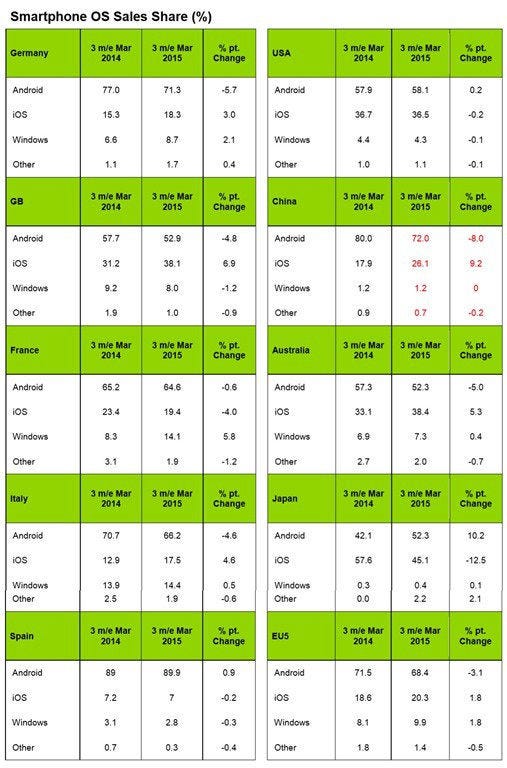Apple iPhone gained share in most major markets in Q1
The latest smartphone OS share numbers from Kantar reveal Apple continuing to ride the popularity of the iPhone 6 and gaining smartphone market share in most major country markets.
May 7, 2015

The latest smartphone OS share numbers from Kantar reveal Apple continuing to ride the popularity of the iPhone 6 and gaining smartphone market share in most major country markets.
Apple’s biggest success was in China, where it gained a remarkable nine points of market share compared to the same period a year ago. This is especially noteworthy considering China’s relatively low per capita GDP, which is around a quarter of typical western economies, and Apple’s premium pricing.
Other than China iOS gained share in the UK, Germany, Italy and Australia but surprisingly not the US. Apple continued its decline from a very high peak in Japan and France, ever the contrarian, seems to be rejecting iOS in favour of Windows Phone.
“In urban China, Apple consolidated its leadership in smartphones, growing its share to 26.1%, up from 17.9% for the same period in 2014,” said Tamsin Timpson of Kantar. “Thirty-eight percent of iPhone buyers were recommended an Apple device by someone they know, while 23% recall seeing an ad.”
“In the first quarter of 2015, the iPhone 6 and 6 Plus continued to attract consumers across Europe, including users who previously owned an Android smartphone,” said Carolina Milanesi of Kantar. On average, across Europe’s big five countries during the first quarter, 32.4% of Apple’s new customers switched to iOS from Android.”
Despite Apple’s apparent stagnation in the US, Kantar reckons it’s driving a dramatic change in the typical screen size of smartphones in the US. Phablets, a term derived by combining the words phone and tablet to describe smartphones with a screen size of 5-inches or more, accounted for 21% of US smartphone sales according to Kantar, up from just 6% a year ago, with almost half on those being iPhone 6 pluses.
One trend emerging from the current iPhone boom is that a higher than usual proportion of Apple loyalists seem to have upgraded to an iPhone 6. While this is good news for Apple’s current numbers, the typical two year postpaid contact cycle might result in relatively disappointing numbers for the iPhone 7, or whatever it will be called.

About the Author(s)
You May Also Like











_1.jpg?width=700&auto=webp&quality=80&disable=upscale)


.png?width=800&auto=webp&quality=80&disable=upscale)